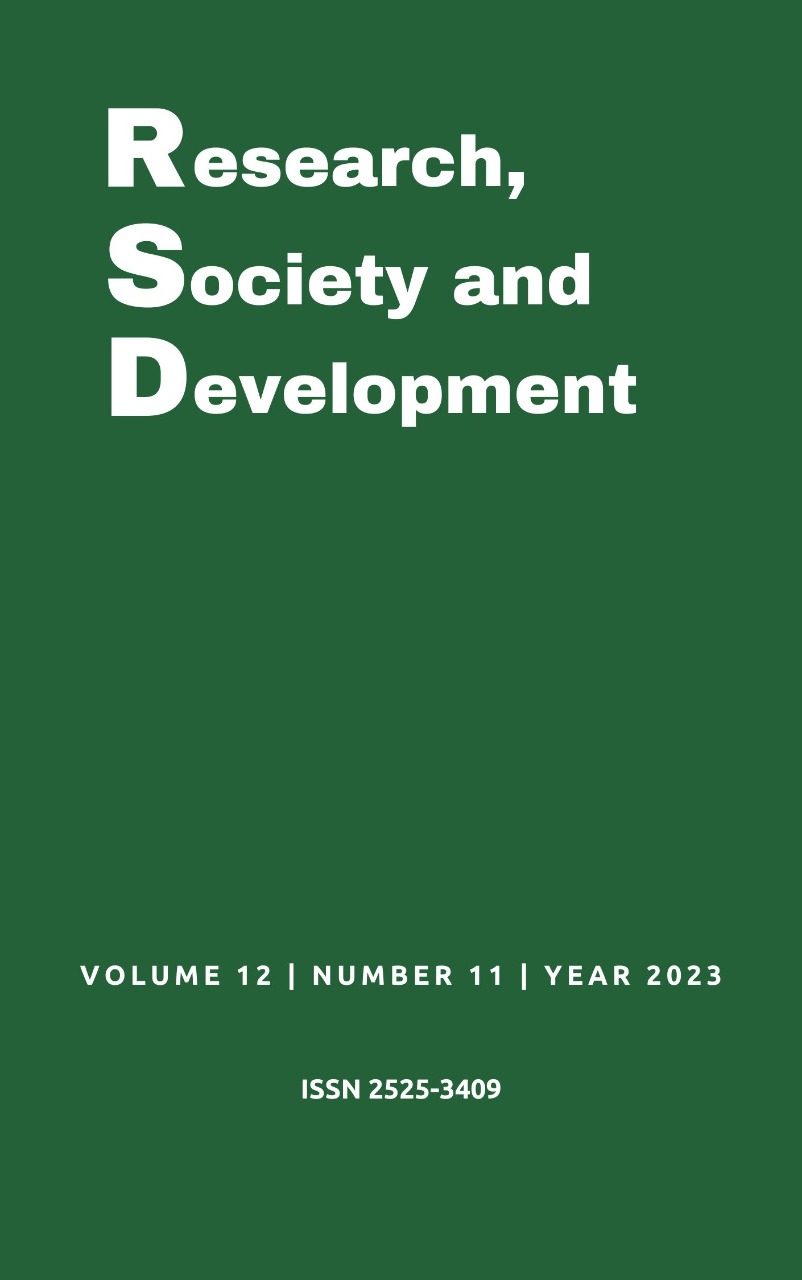COVID-19 and hyaluronic acid in orofacial harmonization
DOI:
https://doi.org/10.33448/rsd-v12i11.43888Keywords:
COVID-19 vaccines, Hyaluronic acid, Face.Abstract
Since the emergence of COVID-19 in Wuhan, the pandemic has spread across the world, causing many deaths and affecting millions of people. Meanwhile, hyaluronic acid has been used in orofacial harmonization to fill wrinkles and grooves in the skin. However, the application of dermal fillers such as hyaluronic acid can lead to a rare complication called delayed intermittent and persistent edema (ETIP), which causes swelling and redness in the treated area. The relationship between ETIP, COVID-19 vaccination and orofacial harmonization has been studied by experts who suggest that ETIP may occur and begin after the vaccine is administered. It is important that healthcare professionals are aware of this possible relationship and inform their patients about the risks before carrying out any aesthetic procedure. Therefore, this narrative review of the literature aims to offer a cataloged document on the relationship between ETIP, COVID-19 and hyaluronic acid as a dermal filler in the clinical practice of orofacial harmonization.
References
Abatangelo, G., Vindigni, V., Avruscio, G., Pandis, L., & Brun, P. (2020). Hyaluronic Acid: Redefining Its Role. Cells, 9(7), 1743.
Chams, N., Chams, S., Badran, R., Shams, A., Araji, A., Raad, M., Mukhopadhyay, S., Stroberg, E., Duval, E. J., Barton, L. M., & Hajj Hussein, I. (2020). COVID-19: A Multidisciplinary Review. Frontiers in Public Health, 8, 383.
Chung, K. L., Convery, C., Ejikeme, I., & Ghanem, A. M. (2020). A Systematic Review of the Literature of Delayed Inflammatory Reactions After Hyaluronic Acid Filler Injection to Estimate the Incidence of Delayed Type Hypersensitivity Reaction. Aesthetic surgery journal, 40(5), NP286–NP300.
Fernandes, Q., Inchakalody, V. P., Merhi, M., Mestiri, S., Taib, N., Moustafa Abo El-Ella, D., Bedhiafi, T., Raza, A., Al-Zaidan, L., Mohsen, M. O., Yousuf Al-Nesf, M. A., Hssain, A. A., Yassine, H. M., Bachmann, M. F., Uddin, S., & Dermime, S. (2022). Emerging COVID-19 variants and their impact on SARS-CoV-2 diagnosis, therapeutics and vaccines. Annals of medicine, 54(1), 524–540.
Funt D. K. (2022). Treatment of Delayed-onset Inflammatory Reactions to Hyaluronic Acid Filler: An Algorithmic Approach. Plastic and reconstructive surgery. Global open, 10(6), e4362.
Graça, M. F. P., Miguel, S. P., Cabral, C. S. D., & Correia, I. J. (2020). Hyaluronic acid-Based wound dressings: A review. Carbohydrate polymers, 241, 116364.
Habas, K., Nganwuchu, C., Shahzad, F., Gopalan, R., Haque, M., Rahman, S., Majumder, A. A., & Nasim, T. (2020). Resolution of coronavirus disease 2019 (COVID-19). Expert review of anti-infective therapy, 18(12), 1201–1211.
Jesus, A. A. de, Suguihara, R. T., & Muknicka, D. P. (2023). COVID-19 and dermal fillers in orofacial harmonization. Research, Society and Development, 12(7), e1612742395.
Juncan, A. M., Moisă, D. G., Santini, A., Morgovan, C., Rus, L. L., Vonica-Țincu, A. L., & Loghin, F. (2021). Advantages of Hyaluronic Acid and Its Combination with Other Bioactive Ingredients in Cosmeceuticals. Molecules (Basel, Switzerland), 26(15), 4429.
Li, A., Fang, R., & Sun, Q. (2022). Delayed inflammatory reactions to hyaluronic acid filler injection: Should be treated but should not be overtreated. Journal of cosmetic dermatology, 21(8), 3625–3626.
Lopes, N. V., Suguihara, R. T., & Muknicka, D. P. (2023). The relationship between hyaluronic acid and COVID-19: a narrative review of the literature. Research, Society and Development, 12(8), e2612842869.
López Pérez V. (2022). COVID-19 and Dermal Fillers: Should We Really Be Concerned?. COVID y rellenos faciales ¿realmente debemos preocuparnos?. Actas dermo-sifiliograficas, 113(9), 888–894.
Majumder, J., & Minko, T. (2021). Recent Developments on Therapeutic and Diagnostic Approaches for COVID-19. The AAPS journal, 23(1), 14.
Munavalli, G. G., Guthridge, R., Knutsen-Larson, S., Brodsky, A., Matthew, E., & Landau, M. (2022). COVID-19/SARS-CoV-2 virus spike protein-related delayed inflammatory reaction to hyaluronic acid dermal fillers: a challenging clinical conundrum in diagnosis and treatment. Archives of Dermatological Research, 314(1), 1-15.
Murray, G., Convery, C., Walker, L., & Davies, E. (2021). Guideline for the Safe Use of Hyaluronidase in Aesthetic Medicine, Including Modified High-dose Protocol. The Journal of clinical and aesthetic dermatology, 14(8), E69–E75.
Ochani, R., Asad, A., Yasmin, F., Shaikh, S., Khalid, H., Batra, S., Sohail, M. R., Mahmood, S. F., Ochani, R., Hussham Arshad, M., Kumar, A., & Surani, S. (2021). COVID-19 pandemic: from origins to outcomes. A comprehensive review of viral pathogenesis, clinical manifestations, diagnostic evaluation, and management. Le infezioni in medicina, 29(1), 20–36.
Rother, E. T. (2007). Revisão sistemática x revisão narrativa. Acta Paul. Enferm, 20(2).
Saboia, T. P. S., Cabral, M. R. L., & Neres, L. L. F. G. (2021). The use of hyaluronic acid in facial matching. Research, Society and Development, 10(14), e94101421731.
Safran, T., Swift, A., Cotofana, S., & Nikolis, A. (2021). Evaluating safety in hyaluronic acid lip injections. Expert opinion on drug safety, 20(12), 1473–1486.
Snozzi, P., & van Loghem, J. (2022). Treatment of Delayed-onset Inflammatory Reactions to Hyaluronic Acid Filler: An Update. Plastic and reconstructive surgery. Global open, 10(10), e4570.
Downloads
Published
Issue
Section
License
Copyright (c) 2023 Viviane Hernandes; Roberto Teruo Suguihara; Daniella Pilon Muknicka

This work is licensed under a Creative Commons Attribution 4.0 International License.
Authors who publish with this journal agree to the following terms:
1) Authors retain copyright and grant the journal right of first publication with the work simultaneously licensed under a Creative Commons Attribution License that allows others to share the work with an acknowledgement of the work's authorship and initial publication in this journal.
2) Authors are able to enter into separate, additional contractual arrangements for the non-exclusive distribution of the journal's published version of the work (e.g., post it to an institutional repository or publish it in a book), with an acknowledgement of its initial publication in this journal.
3) Authors are permitted and encouraged to post their work online (e.g., in institutional repositories or on their website) prior to and during the submission process, as it can lead to productive exchanges, as well as earlier and greater citation of published work.


